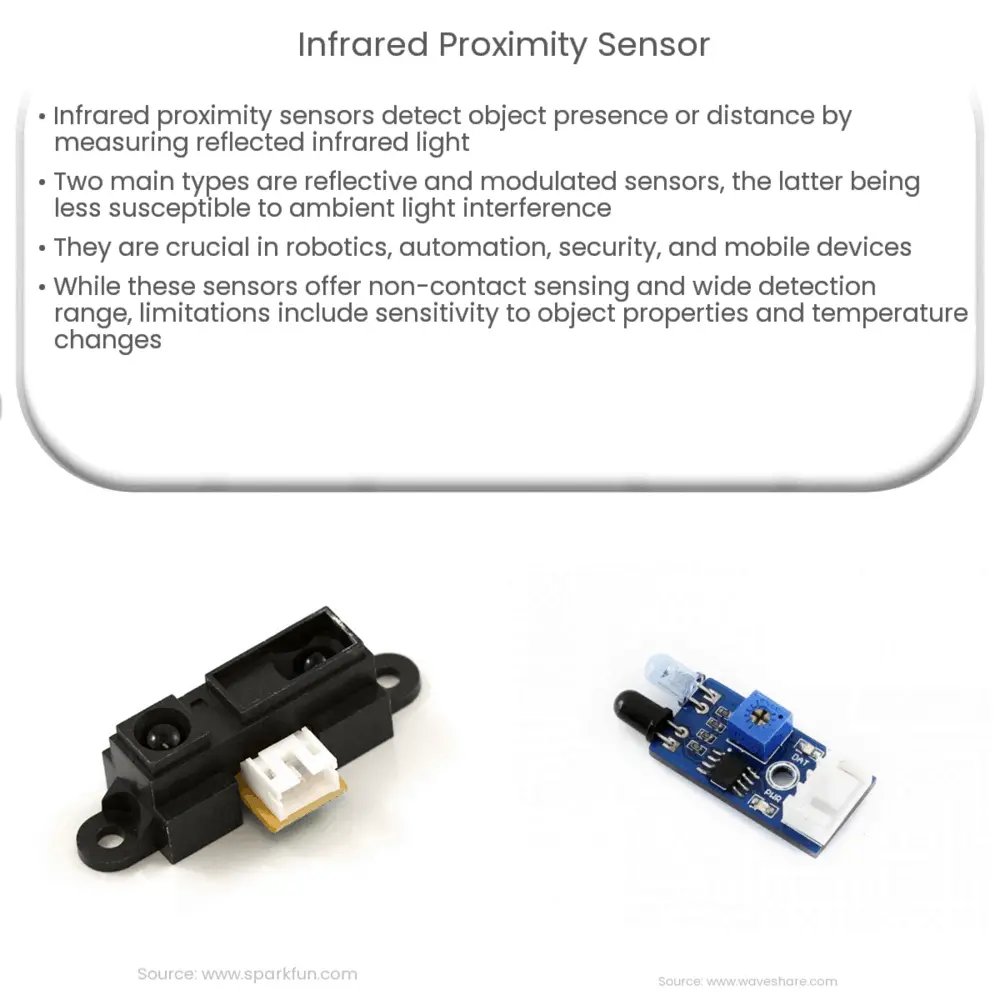Infrared proximity sensors detect objects’ presence or distance using emitted infrared light, enabling non-contact sensing in robotics, automation, and more.

Infrared Proximity Sensor: An Introduction
Infrared proximity sensors are widely used in various applications, from robotics and automation to security systems and mobile devices. They detect the presence or distance of an object by emitting infrared light and measuring the reflected light. In this article, we will discuss the working principle, types, and applications of infrared proximity sensors.
How Infrared Proximity Sensors Work
Infrared proximity sensors work on the principle of infrared light reflection. They consist of an infrared light emitter (usually an infrared LED) and an infrared light detector (photodiode or phototransistor). The emitter sends out infrared light, which is reflected by an object in its path. The detector then measures the intensity of the reflected light, which is proportional to the distance between the object and the sensor. The sensor’s output can be either an analog or digital signal, depending on its design and application requirements.
Types of Infrared Proximity Sensors
There are two primary types of infrared proximity sensors: reflective and modulated.
1. Reflective Infrared Proximity Sensor
Reflective infrared proximity sensors consist of an infrared emitter and detector placed side-by-side or within a single package. The sensor emits infrared light, which reflects off an object and is detected by the photodiode or phototransistor. The strength of the reflected light depends on the object’s distance and surface properties. These sensors are generally more susceptible to interference from ambient light and require a stable background for accurate distance measurement.
2. Modulated Infrared Proximity Sensor
Modulated infrared proximity sensors use a more sophisticated approach to reduce the impact of ambient light interference. The infrared emitter sends out a modulated infrared signal, usually at a specific frequency. The detector then measures the reflected signal and demodulates it to extract the original signal’s strength. By comparing the emitted and received signals, the sensor can accurately determine the distance to the object. This technique makes modulated infrared sensors more reliable and less affected by environmental factors.
Applications of Infrared Proximity Sensors
Infrared proximity sensors are versatile and find application in various industries and use-cases. Some common applications include:
- Robotics: Infrared proximity sensors are used in robotic systems for obstacle detection, collision avoidance, and object recognition. They help robots navigate complex environments and interact with objects safely.
- Automation: In industrial automation, these sensors are used for object counting, conveyor belt control, and product positioning. They ensure accurate and efficient operation of automated systems.
- Security: Infrared sensors can detect the presence of intruders or unauthorized access in security systems. They are commonly used in access control, surveillance, and alarm systems.
- Mobile Devices: Smartphones and other mobile devices often use infrared proximity sensors to detect the user’s proximity to the screen, adjusting display brightness and disabling touch input during calls.
Advantages of Infrared Proximity Sensors
There are several benefits associated with the use of infrared proximity sensors, including:
- Non-contact sensing: Infrared sensors can detect objects without physical contact, reducing the risk of damage to both the sensor and the target object.
- Wide detection range: Infrared sensors can detect objects at various distances, depending on the sensor’s specifications and design. This makes them suitable for a range of applications.
- Resistance to environmental factors: Modulated infrared sensors, in particular, are less susceptible to interference from ambient light, dust, and moisture, providing reliable performance in various conditions.
- Fast response time: Infrared sensors typically offer rapid response times, making them ideal for real-time applications and dynamic environments.
- Compact size: Infrared proximity sensors are often compact, allowing for easy integration into devices and systems with space constraints.
Limitations of Infrared Proximity Sensors
While infrared proximity sensors offer numerous advantages, they also have some limitations:
- Sensitivity to object properties: The performance of an infrared sensor can be affected by the object’s surface properties, such as color, reflectivity, and texture. This can result in variations in detection accuracy for different objects.
- Limited angular detection: Infrared sensors typically have a limited field of view, which may require the use of multiple sensors or additional components to achieve full coverage in certain applications.
- Temperature dependence: Infrared sensors can be sensitive to temperature changes, which may impact their performance and require compensation techniques to maintain accuracy.
Conclusion
Infrared proximity sensors are valuable tools in a wide range of industries and applications, offering non-contact object detection and distance measurement with high accuracy and reliability. Understanding the working principles, types, advantages, and limitations of infrared sensors can help engineers and designers choose the right sensor for their specific application. From robotics and automation to security and mobile devices, infrared proximity sensors continue to play a crucial role in making our world smarter, safer, and more efficient.

